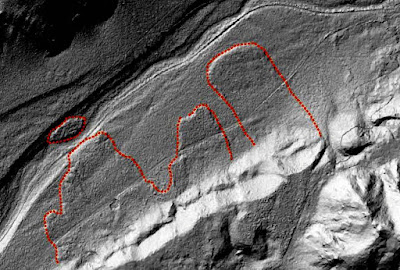The Washington State Department of Natural Resources Division of Geology and Earth Resources has been gearing up for an expansive LiDAR program (DGER LiDAR Presentation). This gearing up is related to new funding as a result of legislative and public awareness that LiDAR can be a powerful tool for geologic hazards. LiDAR has a lot of other powerful applications and with time and better quality LiDAR the imagery and data use will increase. Perhaps the largest challenge is simply data management and ability to provide that data.
In the presentation linked above, the DGER had a LiDAR image of a set of landslides in the Cedar River valley southwest of North Bend, Washington. Below are images I gathered for the Cedar River valley in the same area.
Aerial view of Cedar River (USGS)
LiDAR based DEM from King County
Same image with mark up of landslide deposits
Another section of the valley (LiDAR from King County)
Mark up of slide deposits over glacial age river deposits (LiDAR from King County)
This reach of the Cedar River valley was blocked for a time during the ice age by the Puget ice lobe and then the whole valley was over ridden by the ice. As the Puget ice lobe retreated water flowing out of the Cascades and around the margins of the ice flowed through the valley with later rivers including the modern Cedar River down cutting into the valley fill sediments left by glacial ice, sediments from glacial margin lakes and glacial margin river deposits.
With the right programs, one can use the LiDAR data to emphasize and better visualize the LiDAR based imagery. Below is an an example from the DGER presentation of the same LiDAR images I present above. The DGER images are way better! The two images below are of the same location, but are flipped with the first having north at the top like the images above and the second with north on the bottom. I flipped them because my mind inverts the north oriented image the wrong way.
Below is the North Bend geology map (Dragovitch and others, 2009) that includes the same area.
Landslide deposits and scraps are indicated on the map. If one were producing a map of just large landslide deposits, the map may be a bit different and even the existing map might be tweaked a bit in interpretation based on the high quality LiDAR. For example several of the landslides clearly extended across the river. The detail of the slide deposits is very informative as to how these slides behaved.










No comments:
Post a Comment